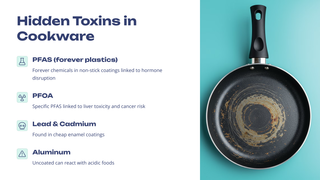Ever stood in your kitchen thinking, “I’m cooking healthy meals, but… is my pan safe?”
With more people choosing clean living and non-toxic lifestyles, there’s a growing worry about what's really hiding in our pots and pans. Teflon? PFAS? Heavy metals? It’s a lot. Especially when all you want is a stir-fry that won’t poison you.
Let’s clear it all up.
This guide breaks down the real pros and cons of ceramic cookware, compares it to stainless steel, and shows you how to build a toxin-free kitchen that matches your clean-living values.
Key Takeaways Table: Ceramic Cookware at a Glance
| Question | Answer |
|---|---|
| Ceramic cookware vs stainless steel — which is better? | Ceramic is non-stick and toxin-free. Stainless steel is ultra-durable and versatile. Use both! |
| What are the pros and cons of ceramic cookware? | Pros: Non-toxic, easy to clean, beautiful. Cons: Can chip, may not last as long. |
| What’s the best affordable non-toxic cookware? | Quality ceramic cookware sets or stainless steel sets from trusted brands. |
| Should I throw out my old non-stick pans? | If they’re scratched, peeling, or made before 2013 — yes. They could be leaching toxins. |

➡️ Click Here: Shop ceramic cookware sets here.
What's the Real Worry with Cookware?
Let’s get real. Cooking clean isn’t just about what’s on your plate — it’s also about how you cook it.
These are some genuine fears I hear from clients all the time:
- “Am I feeding my family harmful chemicals?”
- “What’s the safest cookware for daily use?”
- “Do I need to replace all my pans?!”
As a naturopath, my advice is this: awareness is your first line of defence.
Let’s break down the real risks hiding in some popular cookware types.

The Most Common Toxins in Cookware
1. PFAS & PFOA (AKA “Forever Chemicals”)
Used in many old non-stick pans (like Teflon), these chemicals never break down. Once they’re in your body or the environment — they’re in there for good.
Linked to:
- Hormone imbalances
- Liver toxicity
- Immune suppression
- Cancer risk
2. Lead & Cadmium
These heavy metals sometimes show up in low-quality ceramic glazes, especially in imported cookware. They can leach into food especially acidic dishes like tomato-based sauces.
Risks:
- Kidney damage
- Bone loss
- Developmental delays in kids
3. Uncoated Aluminium
Cheap, reactive, and still found in some older pans. Cooking acidic foods in uncoated aluminium can leach metal into your meals.
Possible links: Neurotoxicity and cognitive decline (research is still ongoing).

What Cookware is Actually Safe?
Here’s what I recommend for my clients (and what I use in my own kitchen at D2E Naturopathy):
Ceramic Cookware Sets (The Non-Toxic Favourite)
Ceramic-coated cookware is a top pick if you’re after the best non toxic cookware that looks as good as it performs.
Why it’s a winner:
- Free from PFAS, PFOA, lead, and cadmium
- Naturally non-stick (without chemicals)
- Easy to clean
- Great for low- to medium-heat cooking
💡 Pro tip: Use wooden or silicone utensils to avoid scratching the surface.
➡️ Click Here: Shop ceramic cookware sets here.
Stainless Steel vs Ceramic Cookware
Stainless steel doesn’t chip, flake, or wear down, and it’s a go-to for sautéing, boiling, and browning.
Why it’s great:
- Completely non-reactive
- Long lifespan
- Oven safe
- Great for searing and deglazing
Ceramic is better for eggs and delicate foods. Stainless steel is better for power cooking. Most health-conscious kitchens use both.
Cast Iron & Enamelled Iron
The OG of cookware. When seasoned right, cast iron becomes naturally non-stick.
- Retains heat beautifully
- Adds dietary iron (bonus!)
- Enamelled versions are easy to clean and won’t rust
Glass Cookware
Excellent for baking and oven use.
- Non-reactive
- Doesn’t leach chemicals
- No stains or smells
Just be mindful: it’s fragile. Handle with care.
Cookware to Avoid
If your current pans have any of the following… it might be time to say goodbye.
- Peeling or scratched non-stick coatings
- Old aluminium with no protective layer
- Plastic utensils used on hot cookware
Ceramic Cookware Pros and Cons
Pros:
- Non-toxic and eco-friendly
- Naturally non-stick
- Easy to clean
- Great for everyday meals
Cons:
- Surface can wear over time
- Not ideal for high-heat searing
- Needs gentle cleaning (no metal scrubbers)
Ceramic Cookware Safety: What the Science Says
Studies suggest that high-quality ceramic cookware (made without lead, cadmium, or synthetic chemicals) is one of the safest options available today.
Q&A: What People Ask About Non-Toxic Cookware
Is ceramic cookware safe?
Yes — when made without toxic glazes or additives. Always buy from trusted brands.
What’s the best ceramic cookware set?
Choose sets that are certified non-toxic, with high heat resistance and solid user reviews. Look for labels like “PFOA/PFAS-free.”
Can ceramic cookware go in the oven?
Most ceramic cookware is oven-safe, but check the manufacturer’s guidelines.
Is stainless steel better than ceramic?
They’re different tools. Stainless is better for durability and high heat. Ceramic is best for chemical-free, low-fat cooking.
What’s the best affordable non-toxic cookware option?
Ceramic sets and stainless steel starter kits are great for beginners — affordable, safe, and easy to use.
Final Thoughts from a Naturopath: Your Cookware Matters
You eat clean. You buy organic. You avoid artificial additives.
But if you’re still cooking on scratched-up, chemical-laced pans you’re not getting the full benefit of your healthy lifestyle.
Your cookware is part of your wellness journey.
At D2E Naturopathy, we believe real health starts in real kitchens. Choosing the right tools like safe, non-toxic ceramic cookware is one of the simplest upgrades you can make.







